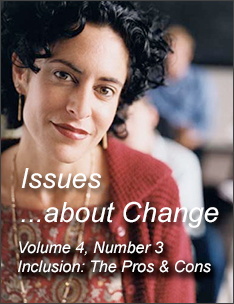Educational Support for Inclusion
Supporters argue the educational merits of inclusion from two perspectives. First, the weaknesses of special education, as it currently is structured, are highlighted. Generally speaking, literature reviews of special education efficacy studies suggest "no advantages for special education placements" (Reynolds, 1988, p. 355). More specifically, the National Association of State Boards of Education (1992) reports the following discouraging information:
- 43 percent of students in special education do not graduate;
- youth with disabilities have a significantly higher likelihood of being arrested than their non-disabled peers (12 percent versus 8 percent);
- only 13.4 percent of youth with disabilities are living independently two years after leaving high school (compared to 33.2 percent of their non-disabled peers); and
- less than half of all youth with disabilities are employed after having been out of school one to two years.
In contrast to these statistics about students with disabilities, the overall high school dropout rate is estimated to be between 18 and 21 percent (McCaul, Donaldson, Coladarci, & Davis, 1992). Further, the overall unemployment rate of high school dropouts in 1992 was 11.4 percent, while students who graduated but did not go on to college had an unemployment rate of 6.8 percent (Kids Count Data Book, 1994).
Another frequent criticism of the current special education system deals with the issue of "labeling effects" on students with disabilities. Inclusion standard-bearers suggest that the very act of labeling a student as "special" frequently lowers expectations and self-esteem (Will, 1986). Further, special education placement in "pull out" programs "has [all too often] left many students with fragmented educations and feeling that they neither belong in the general education classroom nor the special education classroom" (National Association of School Boards of Education, 1992). The impact of such stigmas, lowered expectations, and poor self-esteems on school learning is significant (Lipsky & Gartner, 1992).
Stainback, Stainback, and Bunch (1989) criticize the current special education system as inefficient. They suggest that schools have had to organize a separate system for their students with disabilities. This dual system spends
The separate administrative arrangements for special programs contribute to a lack of coordination, raise questions about leadership, cloud areas of responsibility, and obscure lines of accountability within schools ... The problem at the building level is further compounded by special program teachers working ... in resource rooms. This isolation minimizes communication between special teachers and regular classroom teachers, resulting in a lack of coordination between ongoing classroom instruction and the specially designed remedial instruction. (Will, 1986, pp. 8-9)
Further, because of specific eligibility criteria, some students "fall through the cracks."
Finally, Stainback, Stainback, and Bunch, and others (National Association of State Boards of Education, 1992) suggest that this dual system does not adequately prepare students with disabilities for the "real world," because the "real world" is not divided into "regular" and "special." Consequently, segregated placements with limited interactions between those with disabilities and their non-disabled peers further handicap special education students.
Taken together, these arguments regarding the overall weakness of current special education practices are compelling.
The second educational argument is that "there is now substantial evidence that most, if not all, children with disabilities, including children with very severe disabilities, can be educated appropriately without isolation from peers who do not have disabilities" (Ringer & Kerr, 1988, p. 6). A substantial body of research on school district efforts at inclusion, primarily in the form of case studies, now exists. Although these studies are criticized by full inclusion opponents as more anecdotal than good research, the overall impact of these studies has tended to provide additional momentum for the inclusion movement. According to Lewis (1994), students with disabilities in inclusive environments "improve in social interaction, language development, appropriate behavior, and self-esteem" (p. 72). Inclusion supporters also suggest that as regular and special education faculty work cooperatively together in integrated settings, their coordinated work tends to raise their own expectations for their students with disabilities, as well as student self-esteem and sense of belonging. One additional argument frequently proposed for the further integration of those with disabilities into mainstream classes is that, by interacting with their disabled peers, students will have opportunities to develop positive attitudes toward, tolerance of, understanding of, and true friendships with those who are different from themselves. Indeed, studies show that the general student population are more accepting, understanding, and socially aware of differences when they are incorporated into integrated classroom settings (Staub & Peck, 1994-1995; McGregor, 1993).
Next Page: Concerns About and Arguments Against Inclusion and/or Full Inclusion

